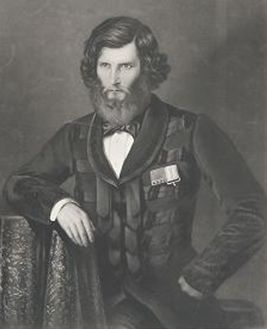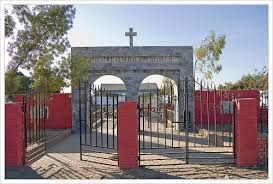John Jacob (East India Company officer) facts for kids
Quick facts for kids
John Jacob
|
|
|---|---|

Brigadier General John Jacob, engraving by Thomas Lewis Atkinson, 1859
|
|
| Born | 11 January 1812 Woolavington, Somerset, England |
| Died | 6 December 1858 (aged 46) Jacobabad, British India (now in Sindh, Pakistan) |
| Buried |
Jacobabad, British India (now in Pakistan)
|
| Allegiance | |
| Service/ |
|
| Years of service | 1828-1858 |
| Rank | Brigadier-General |
| Commands held | 36th Jacob's Horse |
| Battles/wars | |
John Jacob (born January 11, 1812 – died December 6, 1858) was a British officer. He worked for the British East India Company in British India (which is now parts of countries like India and Pakistan). He is famous for creating a special cavalry group called 36th Jacob's Horse. He also founded the city of Jacobabad in what is now Pakistan. There, he helped turn a huge desert area into useful farmland over 20 years. His work brought a lot of growth and wealth to the region.
Contents
Early Life and Career
John Jacob was born in Woolavington, England. His father was a reverend. John went to Addiscombe Military Seminary. This was a special school for young officers. Many famous officers studied there with him.
At 16, he joined the Bombay Artillery. This was part of the Bombay Army. He sailed to India in January 1828. He never returned to England after that.
Serving in the Afghan War
After seven years, John Jacob worked in Gujarat. In 1838, he was sent to Sind. This was during the First Anglo-Afghan War. He first fought in 1839 as an artillery officer.
In 1841, he took command of the Sind Horse. This was a cavalry unit. He also became in charge of the Cutchee frontier. He fought in the Battle of Miani. This battle helped the British conquer Sindh. For his bravery, he was made a Companion of the Order of the Bath.
He then started a second Sind Horse regiment. In 1846, it was named Jacob's Horse. These cavalry groups were very important. They later became the 35th Sind Horse and the 36th Jacob's Horse. They fought in many wars, including World War I.
Building Jacobabad
In 1847, Jacob made his headquarters at Khangurh. This area was a desert. It had many groups who would raid and steal. First, he brought peace by defeating these groups.
Then, he started building the town. He was an architect and engineer. He designed a network of roads. These roads stretched for about 600 miles (965 km). He also solved the water problem. He dug a large tank for water. This water came from the Indus River through a canal.
His biggest project was the Begaree Canal. It started from the Guddu barrage on the Indus River. It went around the district. This canal watered thousands of acres of land. This land was previously dry and unused. It gave many people a way to make a living. The town of Khangurh grew into the city of Jacobabad.
As a Military Engineer and Leader
John Jacob was also a scientist and inventor. He created a special exploding bullet. This bullet could fire combustibles up to 6 miles. He believed it would change how wars were fought. He also designed a special rifle. He had experimental guns made at his own cost.
In 1855, he became a Lieutenant-Colonel. In 1856, he became the Acting Commissioner in Sind. This was a very important leadership role.
Persian War and Later Years
When the Anglo-Persian War started, Jacob led the cavalry. He was promoted to Brigadier-General. He also became an Aide-de-Camp to Queen Victoria. He was put in charge of 3000 men in Bushire. After the war, he managed the British withdrawal.
Soon after, the Indian rebellion of 1857 broke out. Jacob's Horse remained loyal to the British. He wanted to return to India. He was chosen to lead the Central Indian Army. But he was delayed in Bushire. So, the command went to someone else.
Jacob returned to Jacobabad. There, he formed two new infantry regiments. The 130th Baluchis and 26th Jacob's Mountain Battery are named after him. He died in Jacobabad on December 6, 1858. He was buried in the town. His grave is still cared for by the local people. Many locals see him as a very important figure.
Legacy
John Jacob encouraged local people to work together. He divided tasks among families. He saw people working hard even without being told. The local people started calling the new settlement "Jekumbad."
Jacob also wrote about his scientific ideas. He published a pamphlet called "Letters to a Lady on the Progress of Being." This pamphlet talked about early ideas of how living things change over time.
After Jacob died, his simple grave became a special place. Both Muslims and Hindus visited it. They would light an oil lamp there. This practice stopped in the 1930s. But many villagers still visit his tomb. They pray for health and happiness.
Some of John Jacob's relatives also became famous. These include Lt. Gen. Sir Ian Jacob, who was a director of the BBC. Also, Prof. E. F. Jacob, a historian, and Doctor Gordon Jacob, a composer.
Images for kids



